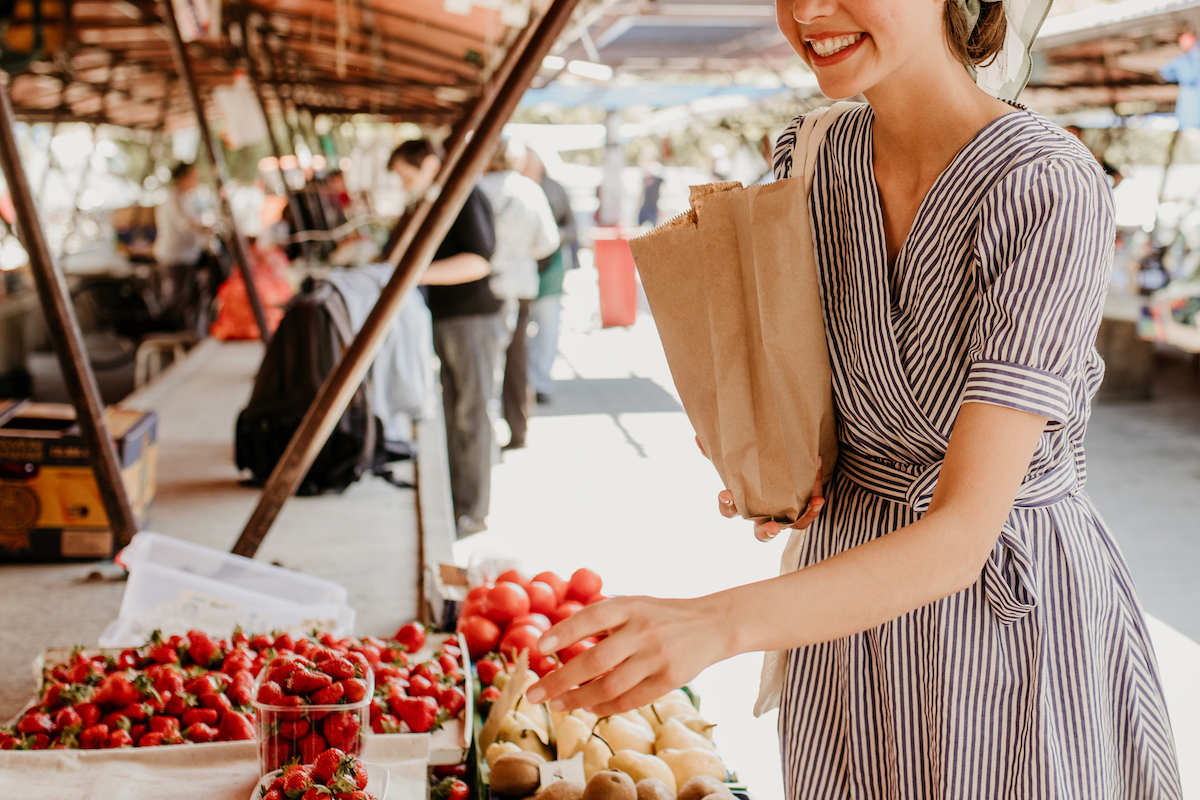The summer of 2023 was all about tomatoes, but not in the way you probably envisioned. Tomatoes became more than just a seasonal cooking staple — they became an aesthetic, an online trend and a way of life. Tomato Girl Summer paved the path for the eponymous Tomato Girl, a young woman who dons flowy dresses and silk headscarves à la Audrey Hepburn and Marilyn Monroe while embodying a picture-perfect lifestyle filled with scenic walks along the Amalfi coast and afternoon feasts of antipasti. Red is a core color of the Tomato Girl’s wardrobe, but certainly not a requirement. Her overall aura is bright and blushing with ripeness, much like the juicy produce.
A year after its inception, the “tomato girl” enjoyed a resurgence, this time with literal tomatoes. In June, Jonathan Anderson, the former creative director behind Spanish luxury fashion house Loewe, unveiled a $3,950 heirloom tomato-shaped clutch bag complete with a gold-hued stem and yellow interiors. The inspiration behind the whimsical clutch? A viral Twitter (or rather, X) meme of a deliciously plump heirloom tomato with waxy skin and pronounced grooves. “This tomato is so Loewe I can’t explain it,” user @homocowboi wrote alongside pictures of the tomato and its glorious cross-section.
This tomato is so Loewe I can’t explain it https://t.co/0zS7HjHxGv
— CONNOR (@homocowboi) June 3, 2024
“Loewe meme to reality,” Anderson captioned an Instagram post revealing his produce-themed purse. With the exorbitant tomato clutch, tomatoes arose as an edible fashion statement within the Tomato Girl multiverse. Because it doesn’t get more Tomato Girl than embracing the slow Mediterranean lifestyle while sporting a literal tomato on your shoulder.
“The tomato isn’t the only muse here. It’s a proclamation of our observations as well,” Hali Bey Ramdene wrote for Bon Appétit. “In the era of the internet, the circuitous, often murky, nature of art and inspiration plays out in a collective conversation that benefits from a degree of obscurity. A meme can enter and leave the zeitgeist like a blazing comet. Inspiration can be captured and made real. In this case, art is not an imitation of life, simply the outcome of it.”
Outside of Loewe, tomatoes have appeared as a recurring motif in haute couture. Per Vogue, there’s Hubert de Givenchy’s 1953 “salt white” dress embroidered with sliced tomatoes, Cynthia Rowley’s 1993 tomato-printed rayon dress and Judith Leiber’s tomato rhinestone minaudière circa 1994. On the runway, tomatoes joined eggplants, zucchinis, hot peppers and Farfalle pasta as big, bold prints in Dolce & Gabbana’s Spring 2012 Ready-to-Wear Collection. They were even painted onto the limbs of models showcasing JW Anderson’s Fall 2023 Menswear Collection. The list is plentiful, underscoring the tomato’s continued prevalence in the worlds of high fashion and art.
We need your help to stay independent
The origins of food-focused art date back to 17th and 18th-century Dutch still life paintings, in which food was utilized as “a narrative device,” wrote Elizabeth Goodspeed for the creative platform It’s Nice That. But in recent years, especially since the pandemic, food fashion has been on the rise, pushing the boundaries of what food can (or can’t) be outside of the kitchen. Back in 2021, artist and designer Nik Bentel launched his viral Barilla-inspired “Pasta Bag,” which he revived the following year with a brand new design akin to a box of De Cecco’s penne pasta. Last June, “condiment couture” entered the fashion vernacular after Kate Spade New York and Heinz joined forces to release a limited-edition line of saucy accessories: tote bags and pouches resembling packets of ketchup, slip-on-shoes adorned with opened ketchup packets, t-shirts emblazoned with Heinz’s iconic typography along with small leather goods, key chains and phone cases. Additionally, Ben & Jerry’s teamed up with Nike to launch their “Chunky Dunky” sneakers — a reference to “Chunky Monkey,” the ice cream brand’s famed flavor. And Moschino once debuted a collection inspired by McDonald’s, in which models dressed like McDonald’s employees and carried Golden Arches-emblazoned handbags on plastic food trays.
Want more great food writing and recipes? Sign up for Salon’s free food newsletter, The Bite.
“What we eat says a lot about our identity. Caviar is posh. Rum raisin ice cream is for old people. Mormons love dirty sodas,” Goodspeed said. “Just as fashion can reflect personal and cultural statements, so too can our food choices broadcast specific social signals and preferences. But the meanings attached to these foods aren’t static; they evolve alongside shifts in societal values and priorities.”
So, what does that mean for tomato fashion?
Tomatoes, with their simple botanical structure and humble price tag, aren’t generally considered a luxury in the same manner as, say, the $19 Erewhon strawberry. But an unblemished, unbruised tomato that’s vibrant in color, firm in texture and brimming with juice — much like the heirloom tomato meme — is certainly both a luxury and a rarity.
look at this tomato I got pic.twitter.com/5BhLaNyzNN
— gianna rosina (@giannarosinaa) June 2, 2024
“I watch people walk around putting heirloom vegetables into their BAGGUs, and they’re not just telegraphing something about the produce they buy, or the food they eat; it’s a statement about the kind of lifestyle they live, or perhaps aspire to live,” wrote Walden Green for Dirt. “Much like the tomato candle, a certain kind of tomato has become a status symbol in its own right. And the Loewe tomato is much closer to one of those luxuriously imperfect heirloom sunbursts than it is to a standard supermarket globe.”
The beauty of heirloom tomatoes lies in their genetics, which stem from the seeds of tomato plants that produced the best fruit and are passed down from season to season. Heirlooms are created to be desirable, unlike their mass market counterparts, which are grown primarily for availability and consistency. “Heirloom produce is heirloom because it’s not genetically engineered to be grown at scale,” Green said. “Scarcity creates exclusivity.”
Indeed, that’s the essence of “tomato girl” couture.


